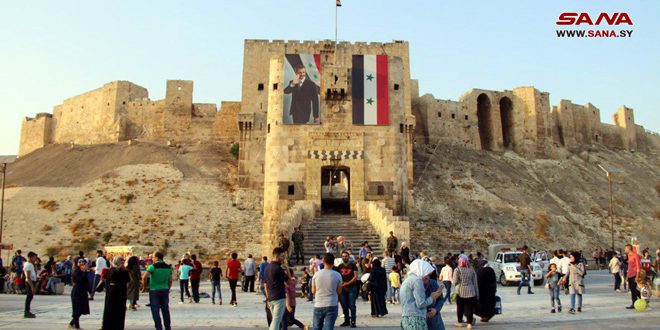The six year anniversary of the liberation of Aleppo from the clutches of terrorism can be viewed as a commemoration of a comprehensive national epic whose words were written by the heroes of the Syrian Arab Army. Aleppo’s liberation has been the starting point for liberation and a title for advancement forward.
Aleppo governorate acquired great importance at all levels, as its vast countryside adjacent to the border with Turkey was the route for thousands of terrorists and mercenaries to be infiltrated by the Turkish regime towards Syria.
The first step to the liberation of Aleppo was the lifting of the siege on Aleppo Central Prison in May 2014 after the legendary steadfastness of the prison garrison that lasted for nearly a year and a half. In the southern countryside of the province, the army laid down its plans and preparations for the liberation which was carried out in stages. Heavy fire preparation began and the infantry forces advanced and reached the international highway linking Aleppo with Damascus. This constituted a first tactical stage for the battles in the southern countryside.
Later, and within a short period, the process of lifting the siege on the Kuweires Military Airport and the Air Force College in the eastern countryside on October 10, 2015 constituted a second decisive blow to the division plan, as the airport and its garrison turned into a basic support force in all battles against terrorists. After cleansing the countryside surrounding the city of Aleppo, the Syrian Arab Army managed to cut off the terrorists’ supply lines and the operations of uprooting terror from the city began and became more powerful and focused, especially with the growing desperation of Western countries and Turkish regime in supporting the terrorists.
The army immediately began operations to purify the eastern neighborhoods of the city from the remnants of terrorism after taking control of Aleppo northern and northwestern parts, thus cutting off completely the supply route through the Castello area. This led to the recovery of al-Kindi Hospital on October 2, 2016, which was in itself a decisive stage to declare the city free from terrorism.
The precise military operations and war tactics that the army followed during the liberation of the city were in line with the nature of the residential neighborhoods in order to preserve the lives of civilians. The liberation of the city of Aleppo was a shot at the heart of the project of division, fragmentation and destruction of the foundations of the Syrian state. In order to complete the picture of the final victory over terrorism, the army units continued their operations in the countryside of Hama and Aleppo and a number of strategic roads were secured between the two governorates.
Military operations continued in the countryside of Aleppo and its vital depth towards the Abu al-Duhur area, culminating in a new victory on January 21, 2017, with the restoration of control over 300 villages and towns in the area between the countryside of Hama, Idlib and Abu al-Duhur military airport.
The dens of terrorism began to collapse at an accelerating rate in various regions under the concentrated strikes of the army. The General Command of the Army and the Armed Forces announced on the 16th of May 2018 the restoration of security and stability to 65 cities, towns and villages in the countryside of Homs and Hama, and forced the terrorists to leave the region to Idlib and Jarabulus after handing over their heavy and medium weapons.
Aleppo has been the key to victory for Syria. Its steadfastness meant overthrowing the most important objectives of the divisional plan for the Syrian state. The victorious liberation of Aleppo was the starting point towards the Syrian east. The victory of Aleppo resulted in the expansion of control and liberation of more than two-thirds of Syria and the return of millions of Syrians to their villages and cities, in addition to the return of stability to all liberated areas, thus, Aleppo has had the largest share of reconstruction in all fields.
NR

